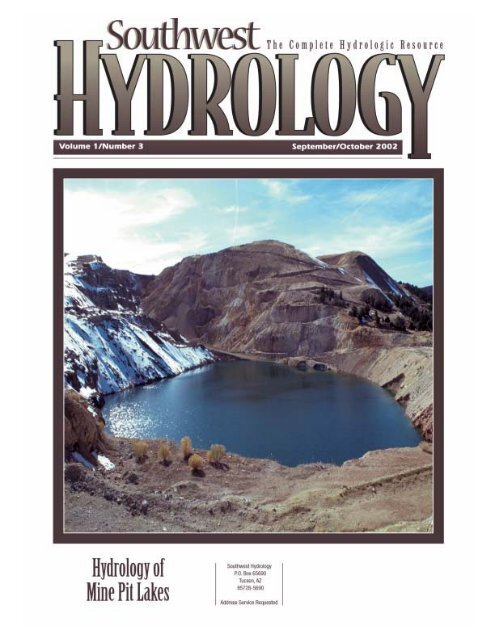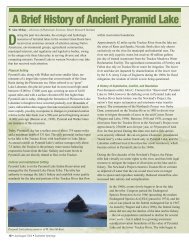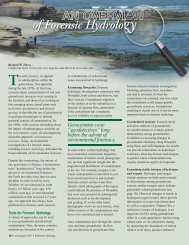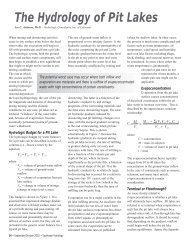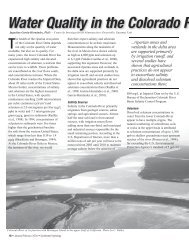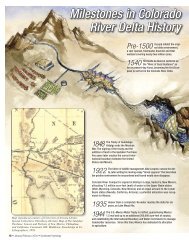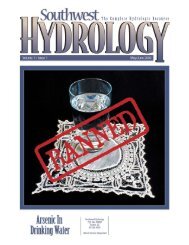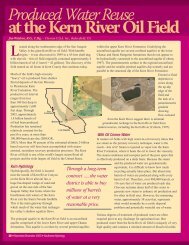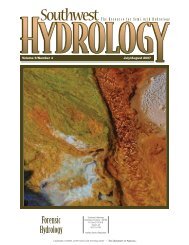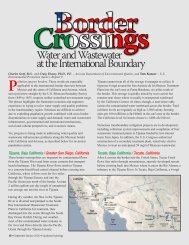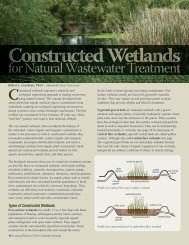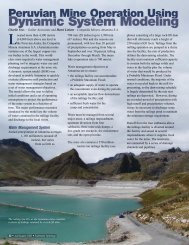Cover & Table of Contents - Southwest Hydrology
Cover & Table of Contents - Southwest Hydrology
Cover & Table of Contents - Southwest Hydrology
Create successful ePaper yourself
Turn your PDF publications into a flip-book with our unique Google optimized e-Paper software.
Inside This Issue<br />
Departments<br />
A bimonthly trade magazine for hydrologists, water managers, and other pr<strong>of</strong>essionals working with water issues.<br />
6 On the Ground<br />
New and on-going projects<br />
including water resources,<br />
cleanups, habitat restoration,<br />
monitoring programs, and more.<br />
9 The State <strong>of</strong> the Nations<br />
Updates and news <strong>of</strong><br />
reservation and tribal activities.<br />
From the Editor<br />
We are pleased by the enthusiastic comments, new subscriptions, and new<br />
advertisers that came in response to our second issue, and we thank you all.<br />
Our cover section for this issue considers the question: what is the hydrology <strong>of</strong> a<br />
very large hole in the ground Hard-rock mine pits are typically large and bound<br />
by metals- and sulfide-rich rock. While some already have lakes in them, many<br />
more will develop lakes once mining stops. No consensus exists about what to do<br />
with them or how they will all turn out decades from now. Should specific<br />
standards exist just for mine pit lakes Can we manage them in perpetuity How<br />
good are the models Can we predict water quality far into the future Even if you<br />
don't regularly work on mining-related issues (perhaps especially if you don't), I<br />
think you'll find it interesting to read through these perspectives and consider the<br />
questions generated by these lakes.<br />
In our next issue, we'll be switching gears again and looking at Natural Resource<br />
Damage Assessments. In general, appraisals assess the value <strong>of</strong> damage to a<br />
natural resource, such as ground- or surface water, and determine appropriate<br />
compensation - not always in terms <strong>of</strong> dollars but more frequently in terms <strong>of</strong><br />
equivalent resources. Such assessments usually involve lawyers and economists,<br />
but hydrologists play a big role as well. Find out more in November.<br />
Thanks to everyone (listed on the opposite page) who contributed to this issue, with<br />
special appreciation to our feature authors, including Glenn C. Miller, who also<br />
loaned us his collection <strong>of</strong> pit-lake slides. As always, I encourage your news, ideas,<br />
and comments.<br />
Betsy Woodhouse<br />
Editor<br />
10 Government<br />
News from the legislature,<br />
agencies, and the courts.<br />
27 The Company Line<br />
What’s new in the consulting<br />
world: contracts, project<br />
announcements, personnel.<br />
28 R & D<br />
What’s happening in research,<br />
education, and technology.<br />
32 The Society Pages<br />
Activities and announcements<br />
from associations, NGOs, and<br />
non-pr<strong>of</strong>it organizations.<br />
36 The Calendar<br />
Meetings, conferences, training,<br />
and short courses.<br />
38 Product Announcements<br />
What’s new on the market.<br />
<strong>Cover</strong>: The Aurora<br />
Partnership pit lake in<br />
Mineral County, western<br />
Nevada. Photograph by<br />
Glenn C. Miller.<br />
CORRECTION<br />
In the article "States Move Forward to Meet New Arsenic<br />
Standard" (pages 18-19 <strong>of</strong> May/June 2002 <strong>Southwest</strong><br />
<strong>Hydrology</strong>), Nevada was mistakenly identified as being the only<br />
state besides New Mexico to sue the EPA over the new 10 ppb<br />
arsenic standard. In fact, Nebraska and New Mexico are the<br />
only states to do so.<br />
4 • September/October 2002 • <strong>Southwest</strong> <strong>Hydrology</strong>
The <strong>Hydrology</strong> <strong>of</strong> Mine Pit Lakes<br />
If you ever have the opportunity to visit a world-class, open-pit mine, do it. Whether<br />
horrified or proud, there’s no substitute for looking into a 1,500-foot deep, two-mile long,<br />
man-made abyss to grasp the magnitude <strong>of</strong> human industriousness. Most <strong>of</strong> the large<br />
mines extend below the water table and will eventually fill with groundwater to form pit<br />
lakes. About forty pit lakes are expected to form in Nevada, predicted to range in size from<br />
mere puddles up to 400,000 acre-feet; and there may be another couple dozen that will<br />
form in other states across the <strong>Southwest</strong>. If you believe the groundwater models, most <strong>of</strong><br />
these will be terminal basins – net sinks that pull in groundwater from all sides,<br />
evaporatively concentrating solutes in the lake. No need to rush, <strong>of</strong> course, because these<br />
pit lakes are expected to remain for thousands <strong>of</strong> years. This, <strong>of</strong> course, is the problem.<br />
– Houston Kempton, Integral Consulting, Inc., Boulder, CO<br />
12 Introduction to Pit Lakes<br />
in the <strong>Southwest</strong><br />
Terry Braun<br />
What happens when mining stops, and<br />
the people and big equipment go<br />
elsewhere This article presents an<br />
overview <strong>of</strong> the issues surrounding<br />
present-day and future pit lakes.<br />
20 Modeling Mine Pit Lakes<br />
Joanna Moreno and Peter Sinton<br />
Models are used to support management<br />
decisions and help with regulatory<br />
evaluations. What approaches are used<br />
to model pit lakes Case studies from<br />
Australia and the United States are<br />
presented.<br />
<strong>Southwest</strong> <strong>Hydrology</strong><br />
Publisher and Editor<br />
Betsy Woodhouse, Ph.D.<br />
Publications and Business Manager<br />
Howard Grahn<br />
Features Editor<br />
Alison Bolen<br />
Assistant Editor<br />
Leslie Ferre<br />
Graphic Design<br />
Debra Bowles/Sun People Studios<br />
Contributors<br />
Lee C. Atkinson, Ph.D.<br />
Roberta Bowen<br />
Terry Braun<br />
Mitch Davis<br />
Michael Foley<br />
Michael Geddis<br />
Brent Haddad, Ph.D.<br />
Kevin Horstman<br />
Houston Kempton<br />
Cathy Ortega Klett<br />
James R. Kuipers, P.E.<br />
Glenn C. Miller, Ph.D.<br />
Joanna Moreno<br />
Peter Sinton<br />
Lucy Wheeler<br />
Printed in the USA by Arizona Lithographers<br />
Published by Woodhouse Press, L.L.C., copyright (c)<br />
2002<br />
14 The <strong>Hydrology</strong> <strong>of</strong> Pit Lakes<br />
Lee C. Atkinson, Ph.D.<br />
When mining and dewatering cease in<br />
any open-pit mine excavated below the<br />
water table, the excavation will fill with<br />
groundwater and form a pit-lake – an<br />
artificial window in the water table.<br />
16 Precious Metals Pit Lakes: Controls on<br />
Eventual Water Quality<br />
Glenn C. Miller, Ph.D.<br />
The chemistry <strong>of</strong> a pit lake reflects the<br />
groundwater conditions prior to mining<br />
and reactions in the rock surrounding the<br />
lake. The water quality will determine<br />
the future use <strong>of</strong> the lake, as well as its<br />
effects on the aquifer, wildlife, and<br />
ecosystems.<br />
18 Water Treatment as a Mitigation<br />
Method for Pit Lakes<br />
James R. Kuipers, P.E.<br />
Pit lake water that exceeds water quality<br />
standards can be treated by a variety <strong>of</strong><br />
physical, chemical, and biological<br />
processes that are capable <strong>of</strong><br />
economically and effectively removing<br />
metals and other elements.<br />
22 Regulating the Unknown: Pit Lake<br />
Policies State by State<br />
Alison Bolen<br />
The long-term environmental impacts <strong>of</strong><br />
pit lakes are still unknown, yet regulators<br />
are moving forward to manage the<br />
impending hazards and potential benefits<br />
<strong>of</strong> these massive, man-made lakes.<br />
24 Dealing with the Legacy<br />
<strong>of</strong> Mine Pit Lakes<br />
Houston Kempton<br />
As many large open-pit mines approach<br />
closure, the challenge is to develop an<br />
affordable framework for long-term, pitlake<br />
management that protects the<br />
environment and advances<br />
environmental science.<br />
UPCOMING FEATURES<br />
Natural Resources Damage Assessments<br />
Watershed Restoration<br />
Tracking Ancient Waters<br />
Desalination<br />
<strong>Southwest</strong> <strong>Hydrology</strong> is printed six times per year by<br />
Woodhouse Press, L.L.C. All rights reserved. Limited<br />
copies may be made for internal use only. Credit must<br />
be given to the publisher. Otherwise, no part <strong>of</strong> this<br />
publication may be reproduced without prior written<br />
permission <strong>of</strong> the publisher.<br />
The ideas expressed herein are those <strong>of</strong> the respective<br />
authors and do not necessarily represent the views <strong>of</strong><br />
<strong>Southwest</strong> <strong>Hydrology</strong> or its publisher.<br />
Subscriptions<br />
Subscriptions to <strong>Southwest</strong> <strong>Hydrology</strong> are available free<br />
<strong>of</strong> charge. Send subscription requests and inquiries to<br />
<strong>Southwest</strong> <strong>Hydrology</strong>, PO Box 65690, Tucson, AZ 85728;<br />
or send email to mail@swhydro.com. To subscribe via<br />
the Web, go to www.swhydro.com.<br />
Advertising<br />
<strong>Southwest</strong> <strong>Hydrology</strong> is financed solely through<br />
advertising. Direct ad inquiries to <strong>Southwest</strong> <strong>Hydrology</strong>,<br />
PO Box 65690, Tucson, AZ 85728; send email to<br />
mail@swhydro.com; call toll-free 866.615-2144. Rates<br />
are available at www.swhydro.com.<br />
Letters and Other Inquiries<br />
Send Letters to the Editor and all other inquiries to<br />
<strong>Southwest</strong> <strong>Hydrology</strong>, PO Box 65690, Tucson, AZ 85728,<br />
phone (520) 615-2144 or toll-free (866) 615-2144, or<br />
send email to mail@swhydro.com.<br />
Editorial Contribution<br />
<strong>Southwest</strong> <strong>Hydrology</strong> welcomes contributions <strong>of</strong> news,<br />
project summaries, product announcements and items<br />
for The Calendar. Send submissions to <strong>Southwest</strong><br />
<strong>Hydrology</strong>, PO Box 65690, Tucson, AZ 85728; or email to<br />
mail@swhydro.com.<br />
Visit www.swhydro.com for additional guidelines<br />
for submissions.<br />
Web Site<br />
www.swydro.com<br />
Sharla Schuller, manager<br />
September/October 2002 • <strong>Southwest</strong> <strong>Hydrology</strong> • 5


